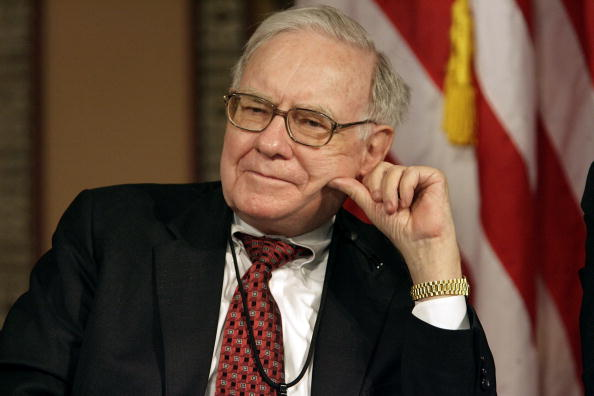Issue #96, Volume #2


A Look At The First Quarter Of Strategy, Trades, And Performance
This is Porter’s Daily Journal, a free e-letter from Porter & Co. that provides unfiltered insights on markets, the economy, and life to help readers become better investors. It includes weekday editions and two weekend editions… and is free to all subscribers.
| Selling cash-secured puts… A deep dive into The Trading Club performance… Selling covered calls for additional income… Powell’s signals from Jackson Hole… New homes outsell existing ones… |
On Monday, we previewed the blockbuster results from the first 77 days of Porter & Co.’s The Trading Club, through August 15.
In today’s Daily Journal, I (Ross Hendricks) will dive deeper into some of the strategies and specific trades that drove these returns. We’ll also explain the downsides of option selling, and how it can all go wrong. First, let’s pick up where we left off on Monday, when we previewed the bread and butter of our trading strategy: selling cash-secured puts.
As of the close of trading last Friday, August 15, we’ve closed eight of our 13 put positions for a total profit of $3,528. These trades required a total capital investment of $66,500 in cash reserves set aside, and had an average duration of 59 days. This works out to an annualized return of 37.6% as shown below:
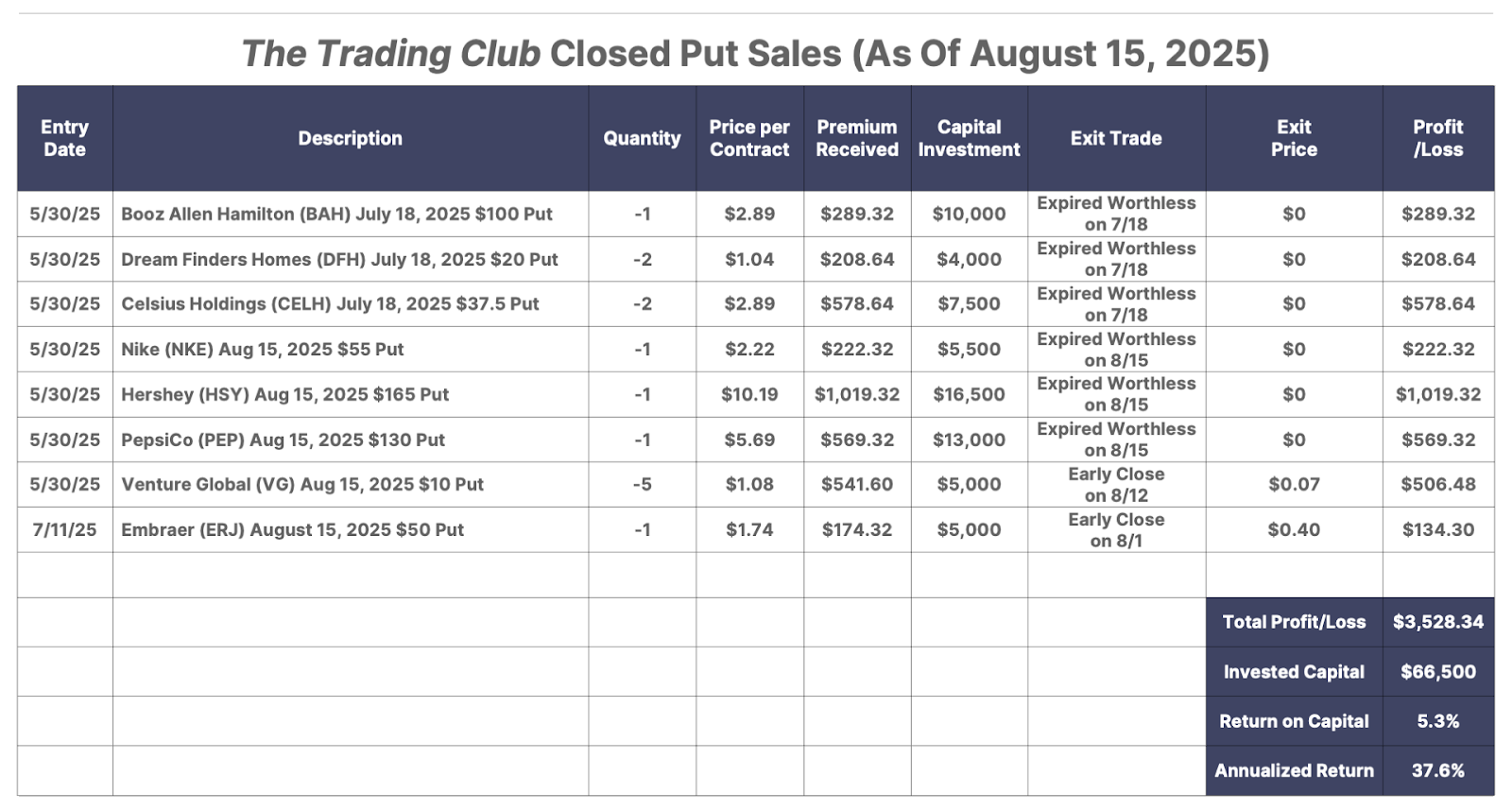
As some of these earlier trades expired or were closed early, we redeployed a portion of the capital into new put sales in shares of tobacco giant Philip Morris International (PM) and mortgage REIT Annaly Capital (NLY), which are both in the green:
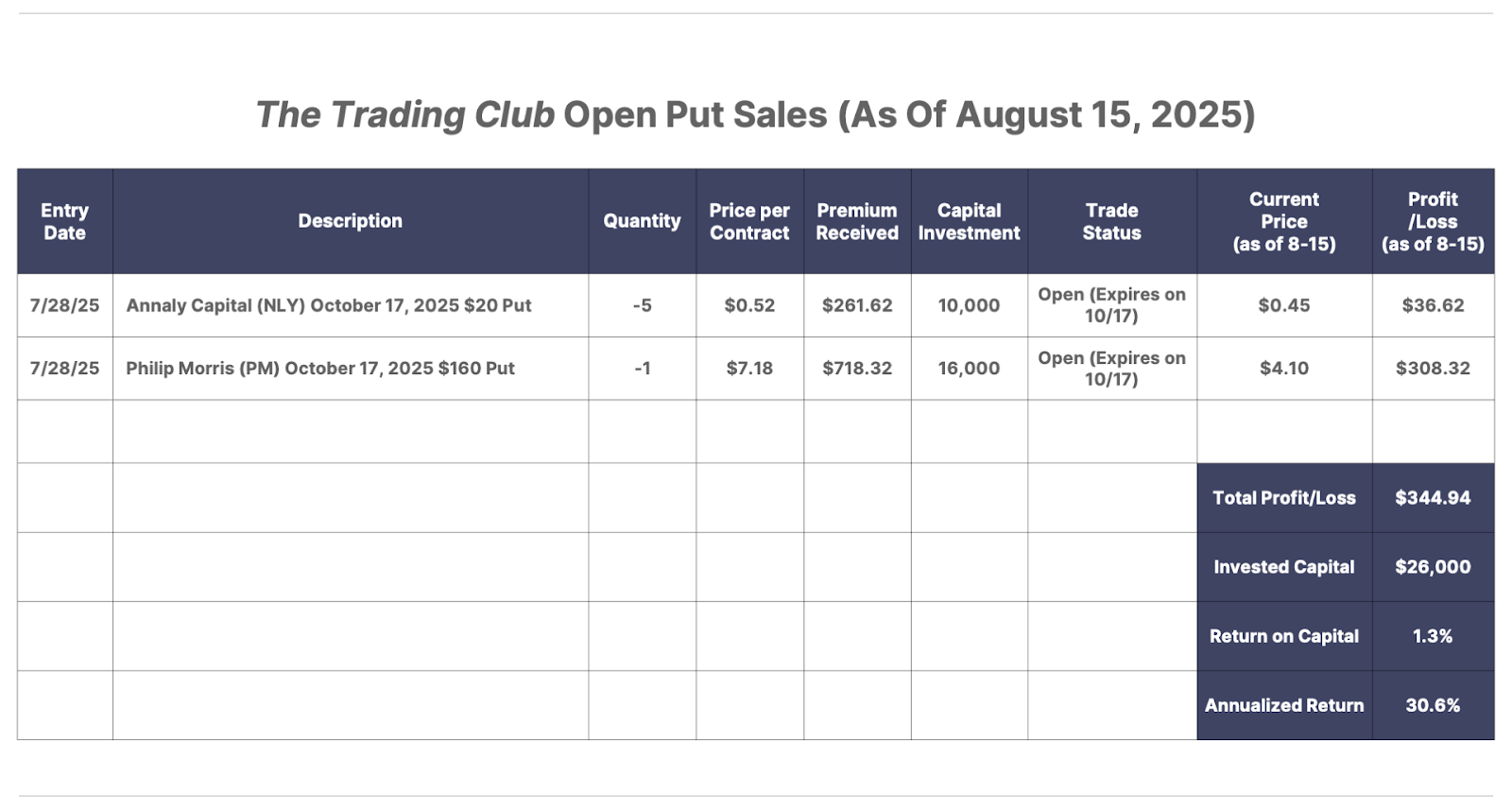
Conversely, three of the put sales we’ve made so far have closed “in the money,” meaning the stock price declined to the point of triggering an assignment, or the purchase of shares in the underlying stock. However, because of the put premium we received – which effectively lowers the cost basis on the position – we’re sitting on profits across all three of these stocks.
The average return across all three of our put sales that were assigned into long stock positions is 4.9%, over an average trade duration of 56 days, working out to a 36.9% annualized return:
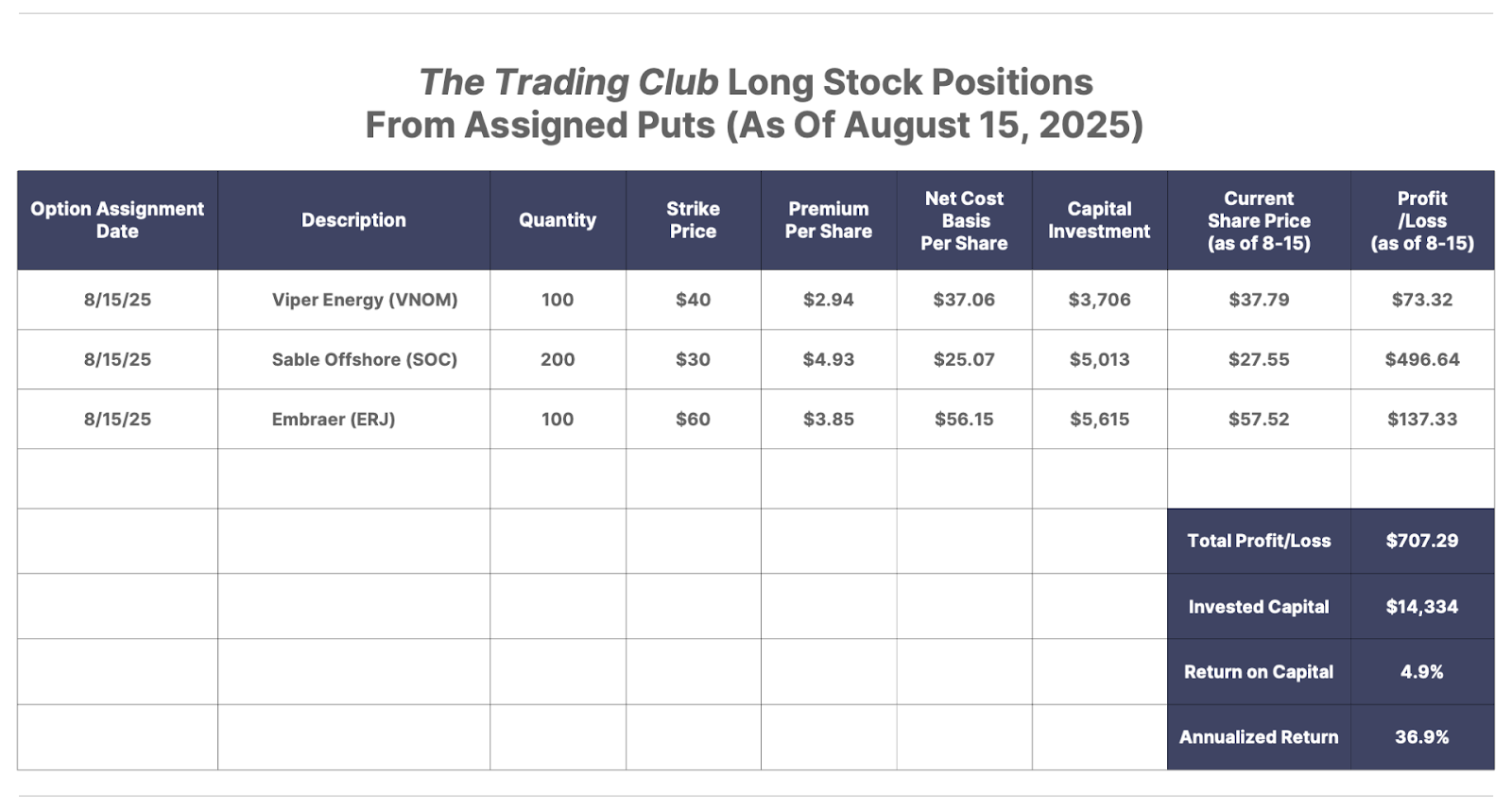
Now, what happens after we end up owning a stock as a result of a put option assignment? In that case, we can turn to our next option selling strategy: selling covered calls for additional income.
We are introducing covered calls with our next batch of trades later this week, where Porter will join me on camera to walk through these trades as we place them in our live tracking account.
We’ll soon open up The Trading Club to new members as we introduce this new strategy. Click here to read all about The Trading Club – mission, strategies, and track record – and to join the waitlist.
Finally, the return potential on selling puts comes with an extra upside kicker. That is, the cash set aside in reserve to fulfill the purchase obligation of each option contract can be held in a money market fund, earning additional interest income (currently around 4%) while the trade plays out.
So in addition to the returns shown above, we’ve also collected an extra $692.77 in interest income on our cash reserves, providing an extra layer of risk-free returns along the way:

In summary, we’re currently (as of August 15) profitable on 100% of our put selling trades. And the total gains across closed, assigned, and open puts plus interest on cash equals $5,273 over the last 77 days.
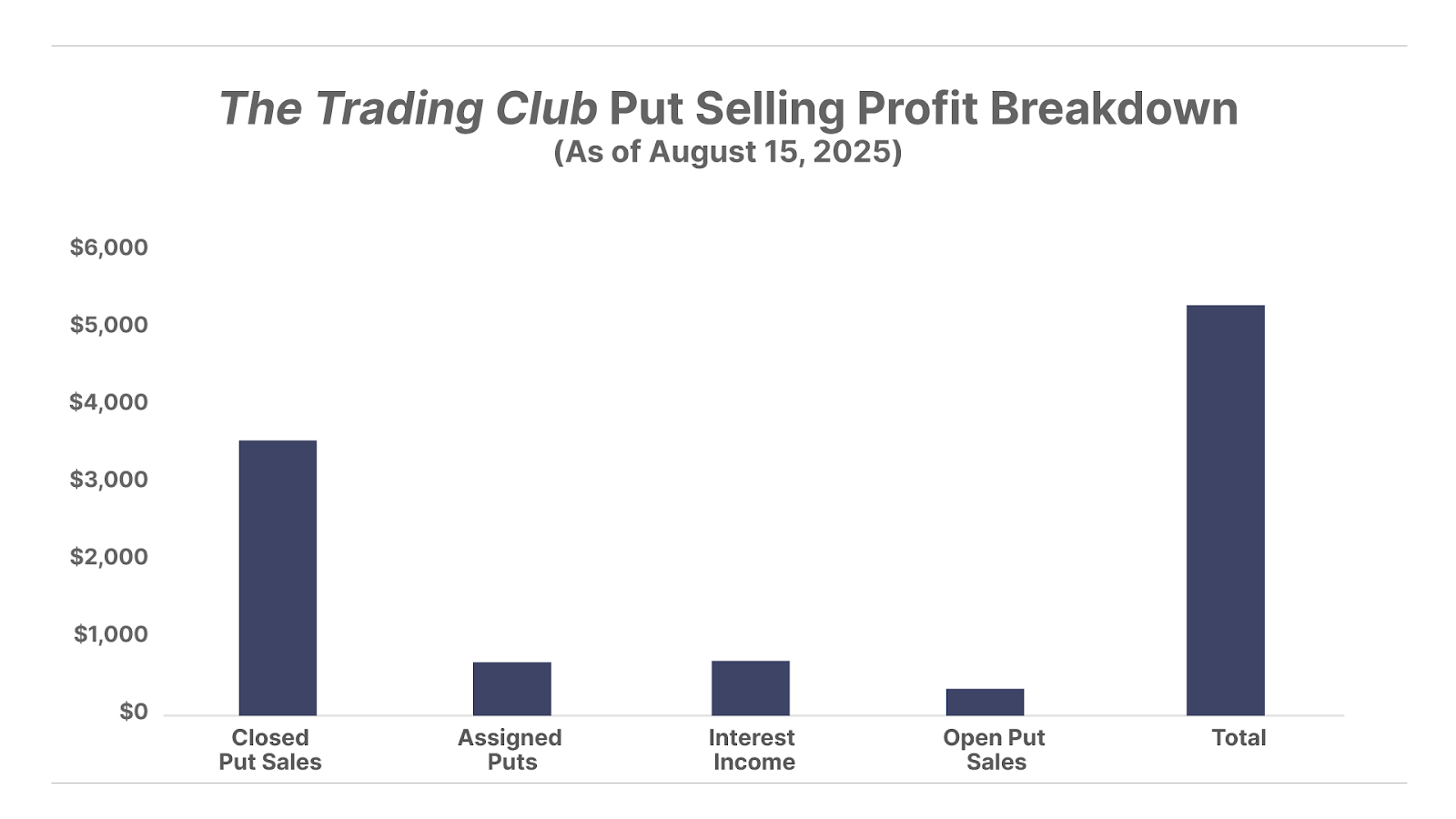
Relative to our starting capital of $100,000, these profits translate into a 27.6% annualized rate of return. And the best part: these returns all came without taking outsized risks.
After all, what was our downside in each of these trades? The chance to own shares in world-class businesses like The Hershey Company (HSY), PepsiCo (PEP), or Nike (NKE) at highly attractive valuations. We don’t know of any other strategy capable of generating 25% annual returns without venturing far out onto the risk curve.
This lopsided risk/reward profile is simply an artifact of the rigged game we’re playing. You see, the vast majority of options contracts ultimately end up as money-losing propositions for the buyer. Our 100% win rate from selling options to date is the living proof.
Now, the astute among you might be asking an important question: who are the suckers at the table here… and why are they willing to consistently show up and lose money, day after day?
The Ultimate Win-Win Proposition
Despite losing money on most trades, option buyers are not rubes. These are typically large, institutional investors like pension funds, endowments, or mutual funds that use options to hedge their portfolios. In many cases, they don’t even have a choice – protecting against downside risk is often part of their official investing mandate. And put options provide them with an efficient way to achieve this protection, as it only requires a tiny fraction of assets to hedge an entire portfolio.
These investors are willing to lose money on their portfolio insurance for the same reasons you and I continue paying our auto or health insurance premiums each month. We know full well that we’ll likely never make money on these policies. But we’re willing to keep paying up simply to avert a financial disaster.
But it’s not all downside for these money managers. What they get in return for buying this insurance is the ability to safely remain fully invested in the market. Thus, the small amount they may lose on their options is more than offset by the gains from the rest of their portfolio.
This insurance function makes options a win-win proposition for both the buyers and sellers. And as a result, the returns available from selling options can be a sustainable source of alpha over the long-term.
Of course, like any area of insurance, there are countless risks involved in options selling. And while it doesn’t take genius to master this game, it does require a certain amount of wisdom, experience, and most of all – underwriting skill – to avoid the landmines lying in wait.
The Downside Of Selling Options
Even with an investing strategy like selling options, where the odds are stacked in your favor, it’s still possible to lose a lot of money.
One of the classic pitfalls is selling options on highly speculative stocks like Tesla (TSLA) or Palantir Technologies (PLTR) – this is a whole different ball game than dealing in “forever stocks” like Hershey, Pepsi, or Philip Morris. One is like selling car insurance to repeat-DUI offenders. The other is like insuring minivans for soccer moms. Which would you choose?
The appeal of selling insurance on highly volatile stocks, like Tesla or Palantir, is that you can earn much higher premiums. We call this “premium chasing,” and it’s the financial equivalent of playing with matches in a dynamite factory. You might win nine times out of 10… but on that inevitable losing trade, when the stock drops 50% or more in a matter of weeks, it can wipe out all previous gains and then some (ask me how I know!).
Even more dangerous are strategies that employ leverage, where the notional value of put options sold (i.e., the total value of stocks you’re “on the hook” to purchase) exceeds 100% of your cash reserves.
Selling puts on margin can turbocharge returns, but here again, even if you win nine times out of 10… it just takes one bad trade to wipe out an entire account (again, ask me how I know!).
If you’re not a seasoned veteran, we suggest avoiding leverage at all costs when trading options. We refuse to trade on margin in The Trading Club. And as we’ve shown with our track record to date, leverage isn’t required to generate market-beating returns.
Countless option selling services lure unsuspecting victims into these and other traps, touting eye-watering gains on individual trades. But what they won’t show you is the sum total of all of their trades in a real-world brokerage account.
That’s why we built The Trading Club to be different from every other trading service out there. Our goal, above all, is to build a strategy that avoids the pitfalls we’ve seen over decades of experience. That doesn’t mean we won’t make mistakes. In fact, that’s the one thing we can guarantee will happen. But we’ll do it with our own money on the line, with full transparency and accountability.
So far, we’ve only covered one component of our strategy: option selling. But subscribers to The Trading Club get access to this plus three other components designed to create a durable investing process that can thrive in both bull and bear markets.
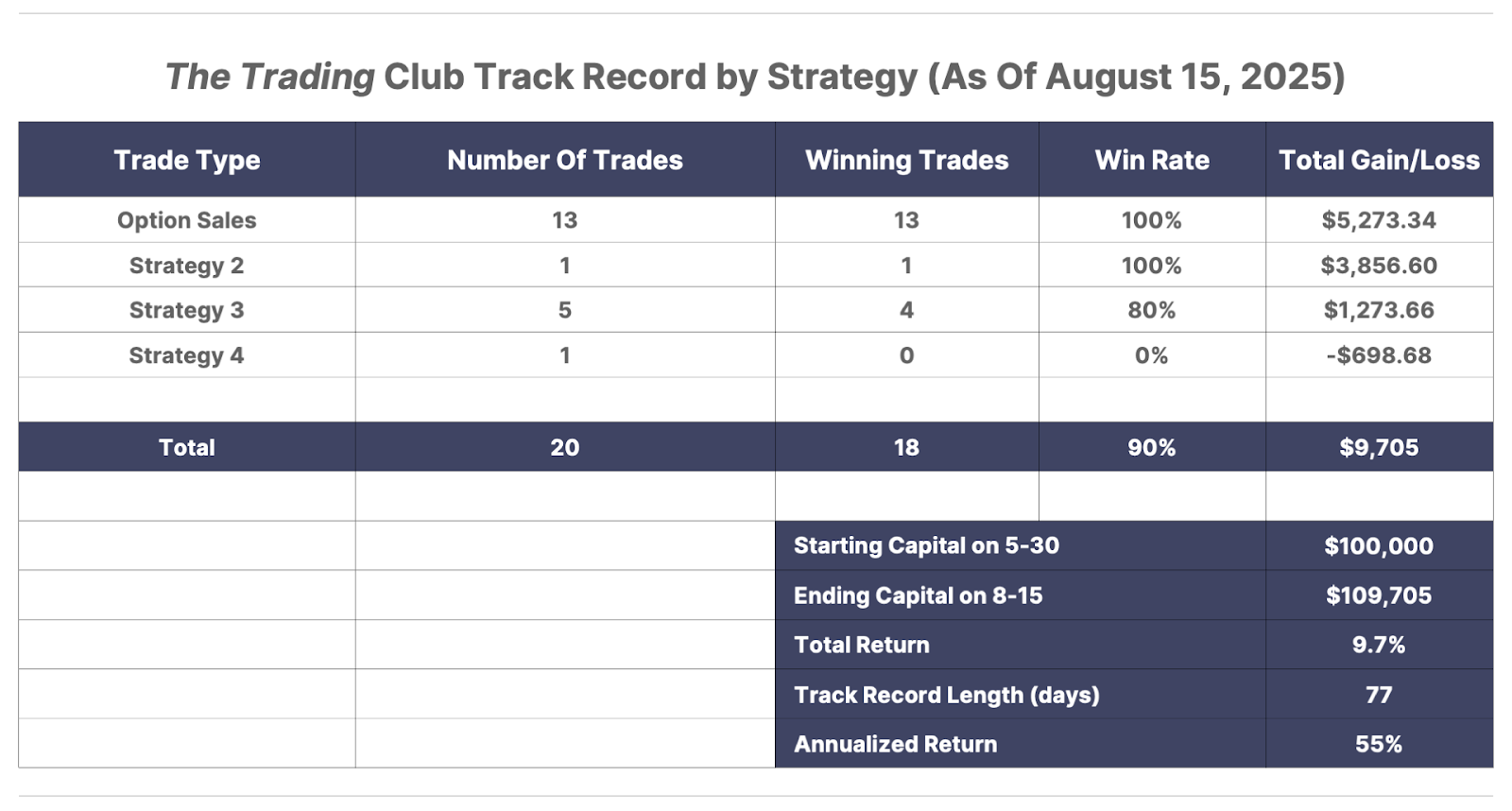
Our ultimate goal: grow this account to $1 million and bring Trading Club members along for the ride, showing them every move we make and why.
If you missed the first $10,000 of gains, don’t worry… we’ve only just begun. We’ve got a long way to go before we hit $1 million. And we’ll release the next series of trades later this week, including a video where we walk you through each trade we place in our live account.
Click here to learn more and to join the waitlist.
Is the World’s Greatest Investor About to Shock Wall Street?
In just a few weeks, a move decades in the making could be revealed – and when it is, it could ignite the next great gold rush. Savvy insiders are quietly positioning now… before Buffett makes it official. Garrett Goggin has already pinpointed four tiny-gold-miners that could 100X once the announcement hits. It’s the perfect moment to be greedy – before the herd wakes up.
Click here to get Garrett’s Top Four gold picks now – before the world’s greatest investor pulls the trigger.
Three Things To Know Before We Go…
1. Non-profitable tech stocks are surging… like it’s 1999. Goldman Sachs’ Non-Profitable Tech Index has jumped 56% since April, double the S&P 500’s 28% gain. The index, which tracks high-growth companies with no or negative earnings, plunged 34% between February and April before staging this sharp rebound. Meme stocks are leading the rally – a potentially foreboding echo of 2021, when the Non-Profitable Tech Index soared 300% in a year only to erase those gains in the 2022 bear market. History suggests that when speculation replaces investing, it’s not a good sign.

2. A historical housing inflection point. For the first time in decades, it is cheaper to buy a new house than a comparable existing house. You see, existing homeowners are hesitant to sell, while home builders are eager to unload inventory. This is because mortgage rates have hovered around a relatively high 7% since October 2022 – making existing homeowners who need to buy a new home reluctant to sell and lose their much-lower mortgage rate. With mortgage rates declining and existing home inventories piling up, the housing market may begin to open up.
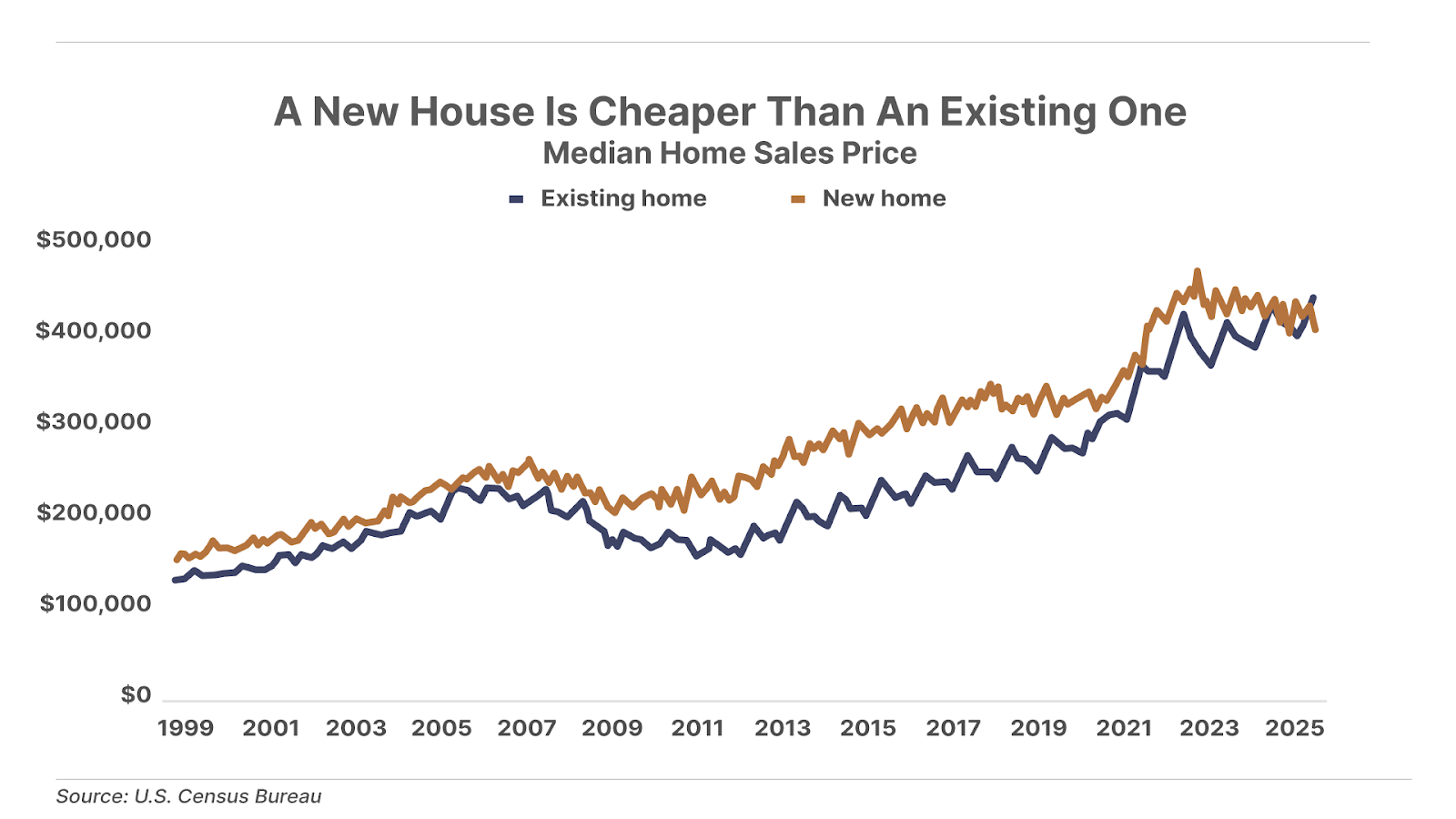
3. All eyes on Jackson Hole. Over the past several years, the Jackson Hole Economic Policy Symposium has been a key stage for major Federal Reserve policy shifts. In 2020 there, Fed Chair Jerome Powell began to tolerate inflation above 2%… in 2022, he signaled aggressive rate hikes to fight rising inflation… and in 2024, he hinted at cuts, which did come, as inflation eased. Now, with Powell’s speech set for Friday, markets are bracing for another signal. Will he hint at a September cut, which the market has priced in, or at staying the course, with CPI inflation having risen each of the last three months – hardly conditions for a cut?
Mailbag
On Monday, we previewed the results since May 30 of Porter & Co.’s The Trading Club… and some current members wrote in to share their experiences. We have included a few here.
I love this Trading Club thing. Love it.
Jeff M.”
Great concept. I started slow with two puts – both winners.
Gerard I.”
I love The Trading Club! This is what I have been looking for since purchasing my first newsletter in 2021. Following your advice for the British American Tobacco (BTI) trade I have already earned back over half of what I paid for my Partner Pass cost! Well done to the team! A 1.86x trade so far with lots of room to run.
Todd A.”
Did great the first round. Keep up the good picks and showing us how to trade options.
Carl P.”
Excellent article. Crystallized the trading method in simple, easily understandable way.
Curtis W.”
Tell us what you think: [email protected]
Good investing,
Ross Hendricks
Houston, Texas
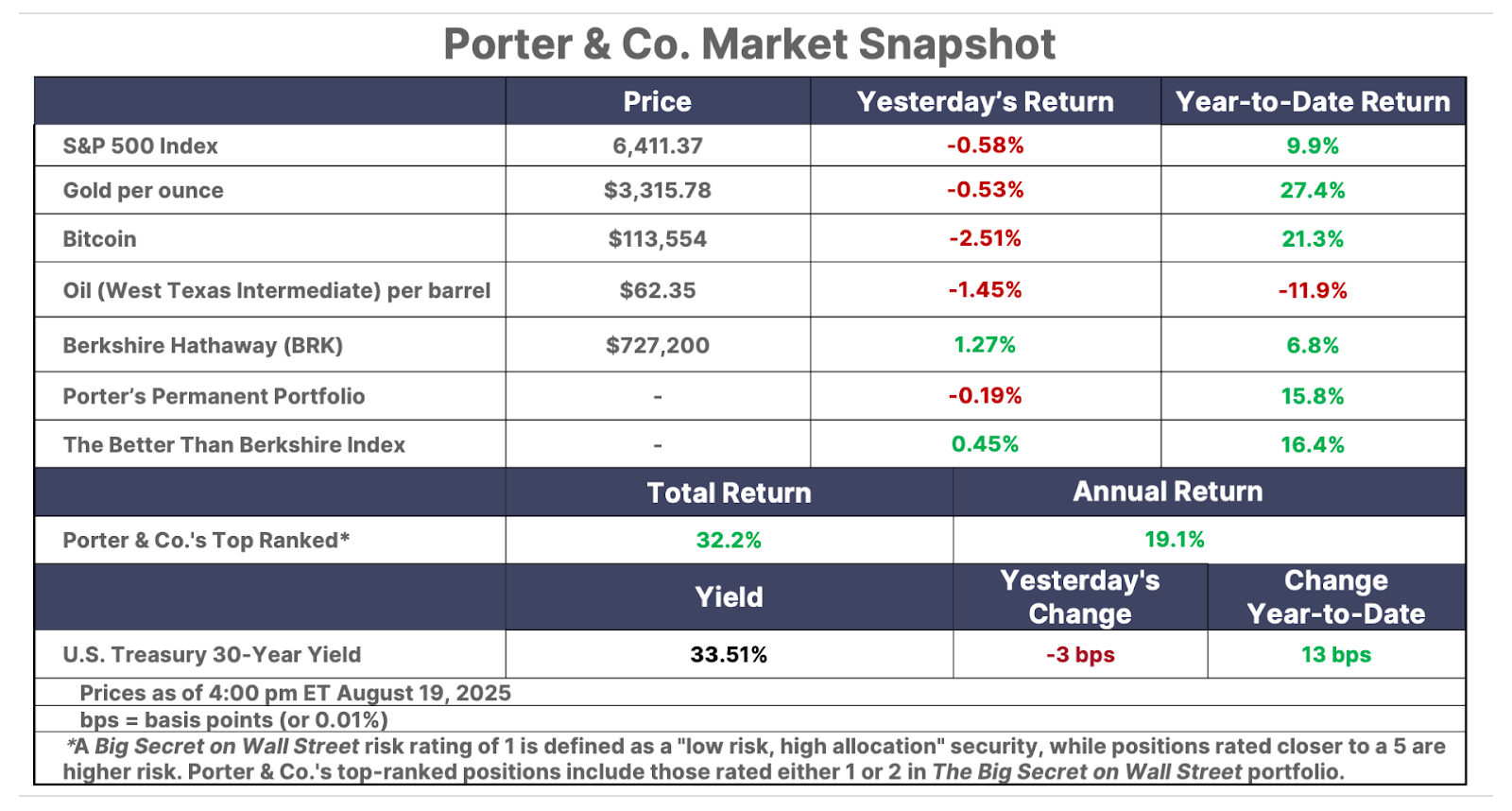
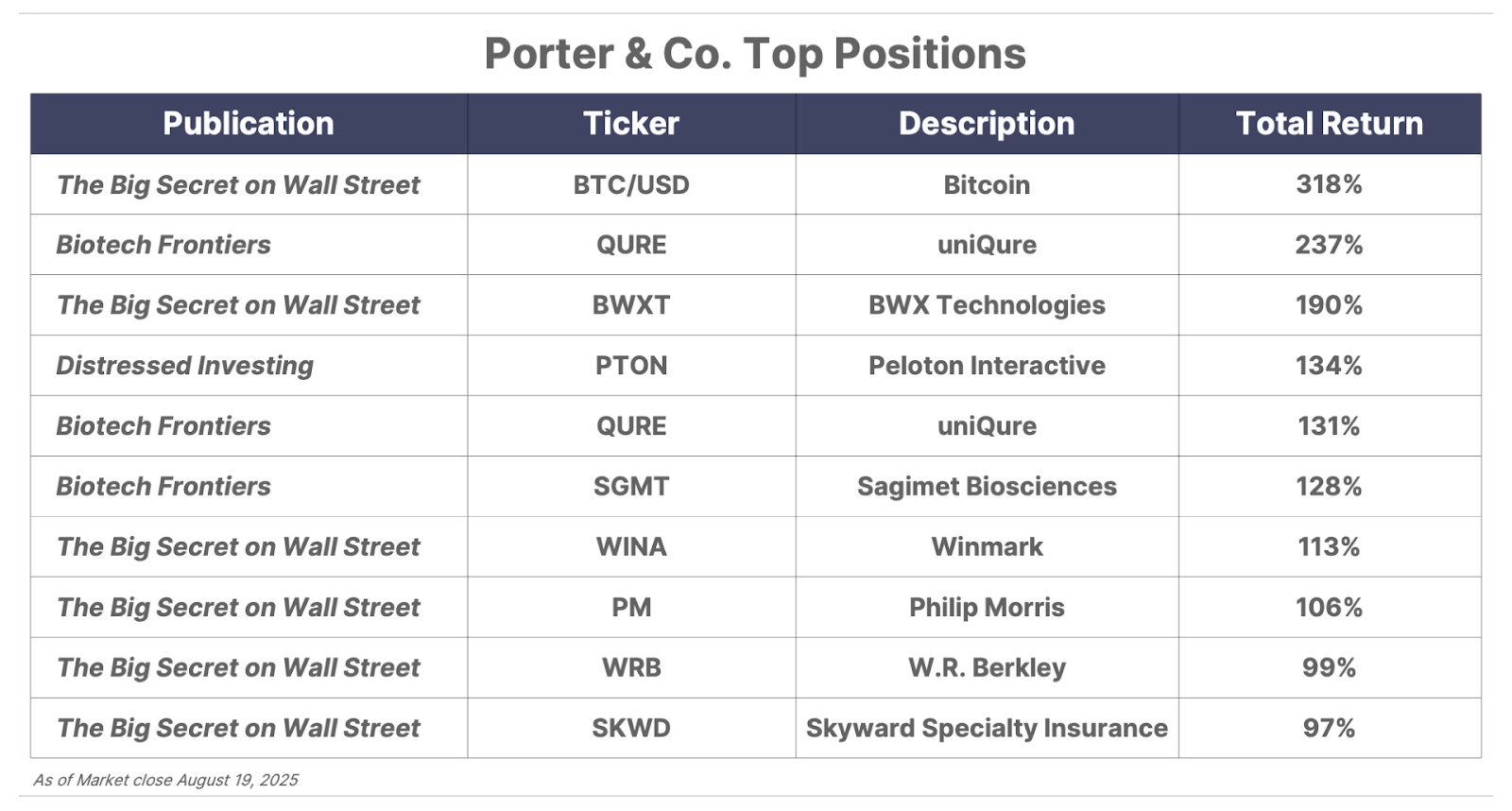
Please note: The investments in our “Porter & Co. Top Positions” should not be considered current recommendations. These positions are the best performers across our publications – and the securities listed may (or may not) be above the current buy-up-to price. To learn more, visit the current portfolio page of the relevant service, here. To gain access or to learn more about our current portfolios, call Lance James, our Director of Customer Care, at 888-610-8895 or internationally at +1 443-815-4447.
